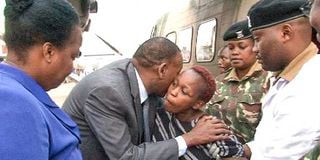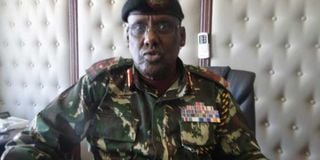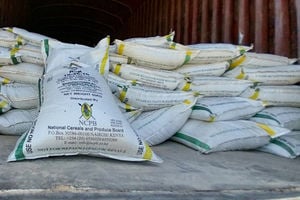Omar Abdi Shurie: How I led risky operation to rescue a teacher from al-Shabaab

Interior Cabinet Secretary Joseph Nkaissery welcomes Ms Judith Mutua at Wilson Airport in Nairobi. With him is Interior Principal Secretary Monica Juma (left).
What you need to know:
- Al-Shabaab terrorists knew how pervasive helplessness sowed in the community eroded trust in state security
- Unlike on the Kenyan side where footprints were visible, it was now a painstaking search for the trail.
The terrorists ran behind a hill to mount a counter-attack, only to find our team ready and alert.
Without sophisticated navigation equipment or sniffer dogs but carrying considerable firepower, the tense officers under the command of Omar Abdi Shurie relied on their instincts and tracking footprints to manoeuvre hostile and expansive terrain as they crossed into Somalia in a race against time to rescue a teacher abducted by terrorists. A sudden burst of gunfire signalled the do-or-die moment. In this second instalment of our exclusive three-part serialisation of Beyond the Call of Duty, Mr Shurie, a former police commander, reveals the untold story of a dramatic mission that could have easily gone wrong — but did not
The abduction of Judy Mutua, a teacher at Hagadera High School, by al-Shabaab on the Wednesday of October 12, 2015, sent the North Eastern region security community back to the drawing board. It indicated that al-Shabaab were changing tactics. They were now targeting non-combatant soft targets. Al-Shabaab needed to shore up their “fighting for God’s mission” by stepping up violence.
They were no match for the Kenyan forces and, to grow their clout, they expanded their operations from raids, Improvised Explosive Device (IED) explosions, vandalism, assault, theft and robberies, to include abduction and kidnapping of girls and women.
The objective of al-Shabaab was to create fear, pain, get ransom and gain publicity. The pain and fear were evident in the subsequent shockwaves this news sent into the local community.
This induced psychological pain and fear, helping to create what terrorists love most – a sense of omnipresence, invincibility and insurmountable capacity to strike anywhere at any time.
Al-Shabaab terrorists knew how pervasive helplessness sowed in the community eroded trust in state security. It undermines community’s own self-defence capacity. This eventuality yields a hopeless people’s obedience to terrorists.
I understood the interest of al-Shabaab in running ahead to do anything to maximise on this high-impact abduction, given its potential for screaming headlines.
They relished the fear and anxiety the news would trigger through the teaching fraternity, students, parents and community, as well as other professionals in the entire North Eastern.
The region was already beleaguered by its own sense of vulnerability.
The national terrorism containment strategy had to quickly adapt to the new realities of small bands of terrorists carrying out activities, often on their own, in the region.
Bring back Judy alive
If my team could bring back Judy alive, it would demonstrate our preparedness in countering the proliferating terrorist cells.
It would not only counter the age-old theory of an ungoverned North Eastern, but the combat itself would also disorganise and pre-empt extremist elements from manipulating the locals into apprehension and winning their minds.
I shared the information about Judy’s abduction with my deputy, and reviewed various options with the County Coordinating Police Commander, Rashid Yakub.
We had to contend with the fact that al-Shabaab had no organised base or structure of command to target there and then. Its bands of fighters were spread in North Eastern region and Somalia, and were activated on a need basis.
This explained why information of Judy’s abduction filtered through in small doses, and was highly incoherent and contradictory.
We released an advance party made up of Kenya Police and the Administrative Police to immediately throw a cordon around Hagadera and Dadaab on the first day.
On the second day, I took over the overall coordination and logistics which entailed evaluating the fragmented information reaching us.
It was not until the close of business on Friday that we received credible intelligence that the abducted teacher had been spotted in Well-Doni.
Two days had been lost since Judy was abducted. I comforted myself, however, that nothing could have been more important than careful intelligence evaluation, even as the anxiety of Judy having been taken across to Somalia in the intervening period hit us hard.
I immediately radioed and mobilised a 100-man team drawn from the National Police personnel from Garissa, Fafi and Dadaab sub-counties. There was no time to waste, and after looking at the weather, destination, target, distance, possible resistance and weapons, I tried to raise their morale.
“Unfreeze your mind ... share tips and feelings. Let us all read from one script now until we return here to report success.”
I looked at their faces. I thought the best I could do was to help them melt away the initial anxiety of venturing into a sudden assignment, and to build determination to succeed under the prevailing circumstances.
Patrol roads
I divided the team into five sectors, with the first running ahead to patrol roads to Liboi, Hagadera, Ifo, Amuma, Hame and Damajale.
The other sectors followed for combat and defence purposes. I took charge of “care-of-man”, by staying on the main road from where I monitored operations as we progressed, and served as the supplier of water, medicine, first-aid and other services.
By 1pm, I had confirmed that we were on the right path, as the kidnappers had used the road and had stopped to fetch water at Well-Yaho in Kulan area.

Senior Assistant Inspector-General of Police Omar Abdi Shurie speaks to the Nation in his office in Garissa on June 9, 2016.
Here, a boy named Abdiwahid Musdhaf Abdikadir, stumbled on them and they kidnapped him too. This was reported at Kulan Police Station.
I recalled all the patrol sectors to converge immediately in Kulan. For the rest of the day, we entered every manyatta, combed every bush in the expansive flat land with sandy soil, straight roads and dotted with trees, the home of white giraffe, dik-dik, gazelle and waterbuck, a few lions and leopards.
We began to see a conspiracy between the gang and a local elder who must have advised them that we were on their trail, hence the need to abduct the boy lest he gave out information.
From Well-Yaho, a village of manyattas inhabited by very forthcoming people who revealed what they knew, we relied on footprints.
My mental map indicated the critical routes: Kulan-Liboi; Damajale-Kulan-Liboi; Hagadera-Welmelle; Welmelle-Hamey; Welmelle-Amuna-Somalia, meaning that we had to cover all the roads in that sprawling area plus all other panya routes to Somalia.
Footprints on the undisturbed sandy soils, that had received a heavy downpour before the kidnappers passed, became the most important guide.
Sensing the need for reinforcements at that point, some 60 kilometres from Garissa town, I radioed the Kenya Defence Forces for air support.
We kept our spirits high. Alarmingly, it was now 4pm on the fourth day with nothing to report.
All signs pointed to Somalia, and I radioed the Somalia National Army to allow our reconnaissance sector cross the border.
The following day, temperatures were boiling, ranging between 33 to 40 degrees Celsius. It was the last of the driest and hottest days of Somalia.
Unlike on the Kenyan side where footprints were visible, it was now a painstaking search for the trail. It meant walking slowly, looking for evidence of human activity, be it shreds of clothes, shoe left behind, disturbed soil or bush.
As if to sabotage our mission, the winds that often precede a downpour suddenly blew softly, then gathered speed and strength, making abrupt change of direction and raising thick clouds of dust that circled around us, throwing pebbles that hit our faces and left dust in our eyes.
The footprints were not visible anymore. I reorganised my men into teams of 15. They now spread out widely, moving back and forth and using their creativity to determine the easiest path the kidnappers, so much in a hurry, would have followed.
I was really motivated by my men as they enthusiastically combed bushes, walked up and down valleys, and checked under the bushes.
The advance party and flank guards took aim every time they came to a tall boulder or baobab tree, most of which had hollow trunks that formed some of the best hideouts for snipers under desert conditions.
As the sun went up, sending its rays to punish us on the fifth day, our advance reconnaissance team signalled that it was a matter of minutes before we reached the kidnappers.
When the moment came, we surrounded the enemy, leaving enough space for manoeuvre. Suddenly the sharp and terrifying sound of gunfire rent the air, and we were engaged in mortal combat with the kidnappers.
“Pop, pop, pop, pop, pop-pop puaaa.” The bullets rained between 7am and about 10am.
The terrorists ran behind a hill to mount a counter-attack, only to find our team ready and alert.
They were smoked out and once cornered, they put up a resistance until the injuries they sustained rendered them powerless.
In their last attempt, they moved to where Judy was, to use her as a shield, a short lived affair as we had anticipated it and stationed some men purposely to prevent that.
“Pop, pop, pop.” More bullets. The disillusioned terrorists dropped their guns and took off towards the bushes under a hail of bullets.
One fighter lay dead when the guns fell silent. Several had escaped with injuries. Judy, covered in a hijab lay behind a heap of sand staring blankly, not screaming, not speaking, just still and emotionless. I guess she could not even tell who her captors were, and the last thing she expected was a rescue.
“Judy,” I called. She looked up and wiped her eyes.
“Judy, we are from Kenya. We are Kenya Police. We are here to rescue you.”
She looked up again and did not even smile, but her brightened face told it all. Though looking haggard and tired, Judy and the boy stood up on sore feet, as my men kept guard.
In the next two minutes, I called Inspector-General of Police, Joseph Boinnet, to update him.
“Judy Mutua has been rescued. Mission accomplished, Sir,” I said.
The helicopter had already arrived, and Judy and the boy were taken on board, accompanied by the African Union Mission to Somalia (Amisom) Country Commander, and the Kenya Defence Forces (KDF) medical team.
Their first stop was the Amisom camp in Somalia, then onto Wajir and finally a hospital in Nairobi.
Our injured officers were treated at the KDF medical centre in Amisom.
As we left for refreshments with my former college mate, Col Joakim Mwamburi, who was in charge of Amisom, I realised the value of competent security personnel.
These men, with neither sniffer dogs nor Global Positioning System navigation equipment, had relied on footprints, and had manoeuvred such a hostile and expansive jungle terrain to accomplish the rescue mission.



